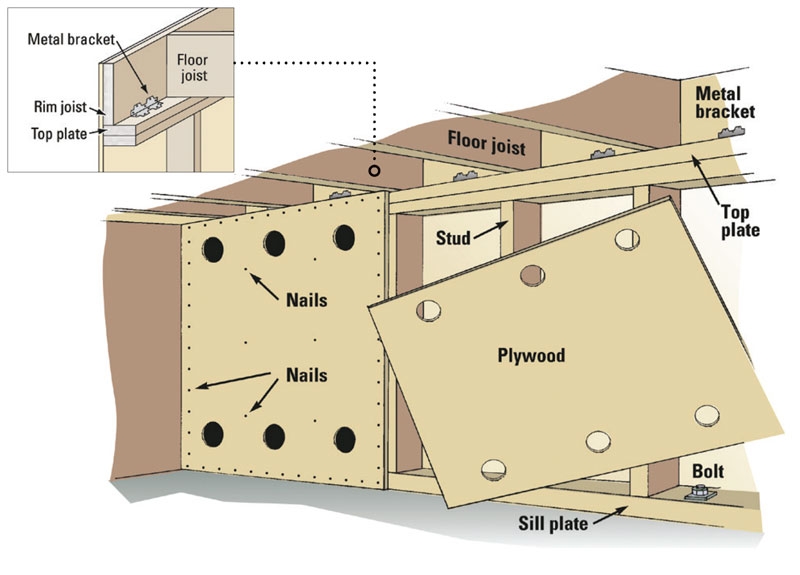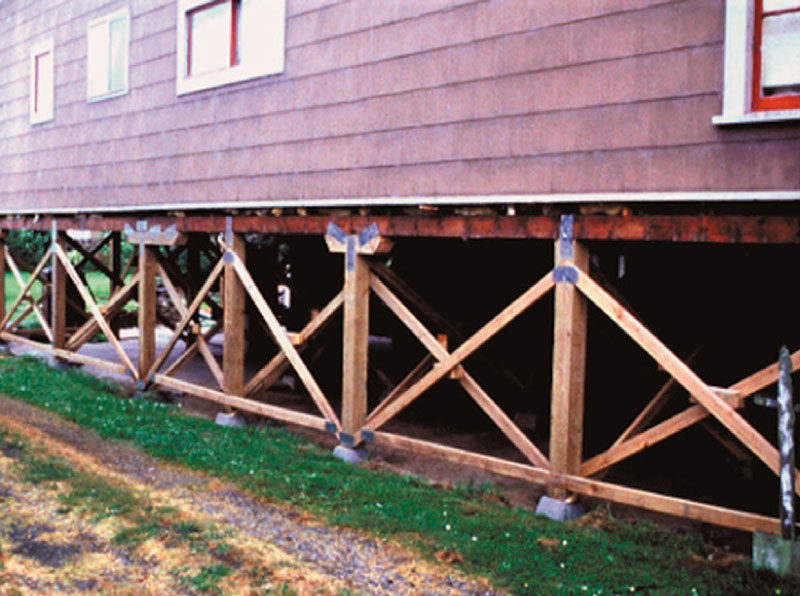Step 4: Minimize Financial Hardship
Earthquakes may last only seconds but they can cause financial hardships that last for weeks, months or years. You can minimize losses by strengthening your home, organizing important documents, and considering insurance.
Common building problems
Buildings are designed to withstand the downward pull of gravity, yet earthquakes shake a building in all directions— up and down, but most of all, from side to side. The following presents some common structural problems and how to recognize them.
Inadequate Foundations
Look under your house at your foundation. Look for bolts in the mudsills. They should be no more than six feet apart in a single story and four feet apart in a multistory building.
Unbraced Cripple Walls
Homes with a crawl space should have panels of plywood connecting the studs of the short “cripple” walls.
Soft First Stories
Look for large openings in the lower floor, such as a garage door or a house built on stilts. Consult a professional to determine if your building is adequately braced.
Unreinforced Masonry
The most typical type of unreinforced masonry in Northern California is brick. While there are few brick homes in our area, many older buildings have unreinforced brick chimneys. If your house has brick or blocks as a structural element, consult a professional to find what can be done and to determine if it is safe.
Reinforcing Crawl Spaces

If you live in a mobile home…
Mobile homes can easily slide off their foundations if not properly secured to resist side-to-side motion. Look under your home—if you only see a metal or wood “skirt” on the outside with concrete blocks or steel tripods/jacks support your home, you need to have an “earthquake-resistant bracing system” (ERBS) installed.
For those who rent
As a renter, you have less control over the structural integrity of your building, but you do control which apartment or house you rent. When looking for housing, remember:
- Apartment buildings have to meet the same codes and structural requirements as houses.
- Avoid rental units made of unreinforced masonry or those with “tuck-under” parking spaces on the ground floor.
- Consider the safety of attached structures such as stairways and balconies, which can break during an earthquake.
Ask your landlord these questions:
- What retrofitting has been done on this building?
- Has the water heater been strapped to the wall studs?
- May I secure furniture to the walls?
More Ways to Protect Yourself Financially
Identify your important documents and place them in a safe space. These include property deeds, insurance policies, vehicle titles, wills, bank accounts and stocks and bonds, credit cards and personal information such as passports, driver’s licenses and marriage/birth certificates. Consider scanning these documents and keeping them electronically or making paper copies. Take photos or a video of the interior and exterior of your home and your personal belongings to make an inventory for insurance purposes.
You can further protect your home with earthquake and flood insurance. Without insurance, you will be responsible for all costs to repair or rebuild your home and replace your persona property. Residential policies do not cover earthquake or flood damage. For more information, see earthquake and tsunami flood insurance page.
Insurance for Earthquake and Tsunami Flooding
To help reduce financial hardship after an earthquake or tsunami, consider getting insurance today!
Strengthining Your "Pier and Post" Foundation “Pier and post” or “post and beam” foundations consist of wooden posts on isolated concrete footings, which support the entire structure. Many homes in rural Northern California use this foundation system. This type is particularly vulnerable to the strong sideto-side shaking from earthquakes. There is no question that the best foundation to resist earthquake shaking is a continuous perimeter foundation, but for many Northern California residents, the cost of installing such a foundation is prohibitive.
It is possible, however, to strengthen your pier and post foundation at relatively low cost. The bracing system pictured here will increase resistance to lateral forces for your home. The bracing should be installed around the perimeter of the structure and, at a minimum, every second line of interior posts. This type of strengthening should be considered adequate for short term stabilization until you are able to install a permanent, concrete, perimeter system.
If you live in California, check out the Earthquake Brace + Bolt Program. This program provides funding for residential seismic retrofitting. Check out the website to see if you qualify.
Find out more about strengthening your home at earthquakecountry.org.
